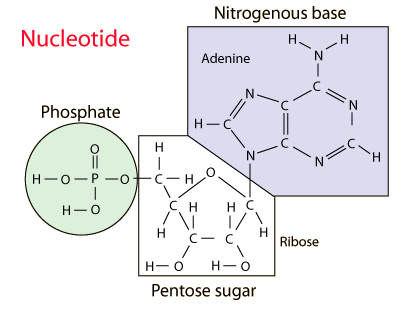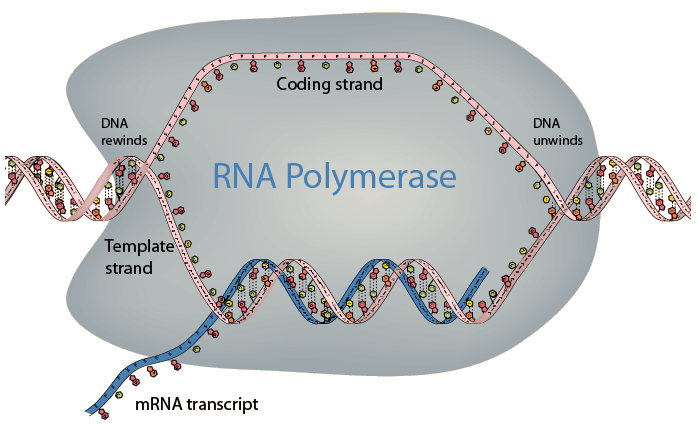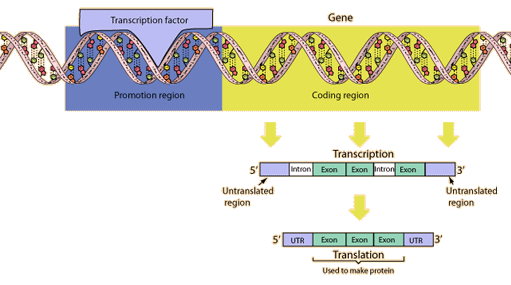
messenger rna
Nucleotides
Nucleotides are the basic structural units of nucleic acids, which control the production of proteins in living organisms. The nucleotides are made up of a phosphate group, a pentose sugar, and a nitrogen base.


Messenger RNA
The ribonucleic acid (RNA) that is directly involved in the transcription of the pattern of bases from the DNA to provide a blueprint for the construction of proteins is called messenger RNA or typically mRNA.


References:
Wiki Messenger RNA


References:
Wiki Messenger RNA
Proteins
Proteins are the "workhorse" molecules of life, taking part in essentially every structure and activity of life. They are building materials for living cells, appearing in the structures inside the cell and within the cell membrane. While many of the proteins are structural proteins, many are regulatory proteins called enzymes.
They contain carbon, hydrogen, and oxygen like the carbohydrates and lipids, but they also contain nitrogen and often sulfur and phosphorus.
Protein molecules are often very large and are made up of hundreds to thousands of amino acid units. The 20 amino acids are combined in different ways to make up the 100,000 or so different proteins in the human body. Some of these proteins are in solution in the blood and other fluids of the body, and some are in solid form as the framework of tissue, bone and hair. Shipman, et al. suggests that they make up about 75% of the dry weight of our bodies.
Proteins can be characterized as extremely long-chain polyamides. The amides contain nitrogen, and nitrogen composes about 16% of the protein atomic content. These proteins are created in the body by condensation of amino acids under the influence of enzyme catalysts, using patterns or direction from the nucleic acids in the cells.
The amino acid units in a protein molecule are held together by peptide bonds, and form chains called polypeptide chains. The sequencing of the 20 amino acids forms a kind of alphabet for expression of the type of protein, leading to a very large number of types of proteins.
In the cell, the DNA directs or provides the master blueprint for creating proteins, using transcription of information to mRNA and then translation to actually create proteins.
A comment from Miller "Living things, after all are constructed by the execution of a series of genetic messages encoded in DNA. Genes, the functional units of that genetic program, generally encode proteins, which are the workhorses of the cell. As our exploration of the genomes of humans and other organisms expands, it becomes clear that those proteins can do just about everything required to produce an organism ..."
Wiki: protein structure
Structural Proteins.
Protein molecules are often very large and are made up of hundreds to thousands of amino acid units. The 20 amino acids are combined in different ways to make up the 100,000 or so different proteins in the human body. Some of these proteins are in solution in the blood and other fluids of the body, and some are in solid form as the framework of tissue, bone and hair. Shipman, et al. suggests that they make up about 75% of the dry weight of our bodies.
Proteins can be characterized as extremely long-chain polyamides. The amides contain nitrogen, and nitrogen composes about 16% of the protein atomic content. These proteins are created in the body by condensation of amino acids under the influence of enzyme catalysts, using patterns or direction from the nucleic acids in the cells.
They contain carbon, hydrogen, and oxygen like the carbohydrates and lipids, but they also contain nitrogen and often sulfur and phosphorus.
Protein molecules are often very large and are made up of hundreds to thousands of amino acid units. The 20 amino acids are combined in different ways to make up the 100,000 or so different proteins in the human body. Some of these proteins are in solution in the blood and other fluids of the body, and some are in solid form as the framework of tissue, bone and hair. Shipman, et al. suggests that they make up about 75% of the dry weight of our bodies.
Proteins can be characterized as extremely long-chain polyamides. The amides contain nitrogen, and nitrogen composes about 16% of the protein atomic content. These proteins are created in the body by condensation of amino acids under the influence of enzyme catalysts, using patterns or direction from the nucleic acids in the cells.
The amino acid units in a protein molecule are held together by peptide bonds, and form chains called polypeptide chains. The sequencing of the 20 amino acids forms a kind of alphabet for expression of the type of protein, leading to a very large number of types of proteins.
In the cell, the DNA directs or provides the master blueprint for creating proteins, using transcription of information to mRNA and then translation to actually create proteins.
A comment from Miller "Living things, after all are constructed by the execution of a series of genetic messages encoded in DNA. Genes, the functional units of that genetic program, generally encode proteins, which are the workhorses of the cell. As our exploration of the genomes of humans and other organisms expands, it becomes clear that those proteins can do just about everything required to produce an organism ..."
Wiki: protein structure
Structural Proteins.
Protein molecules are often very large and are made up of hundreds to thousands of amino acid units. The 20 amino acids are combined in different ways to make up the 100,000 or so different proteins in the human body. Some of these proteins are in solution in the blood and other fluids of the body, and some are in solid form as the framework of tissue, bone and hair. Shipman, et al. suggests that they make up about 75% of the dry weight of our bodies.
Proteins can be characterized as extremely long-chain polyamides. The amides contain nitrogen, and nitrogen composes about 16% of the protein atomic content. These proteins are created in the body by condensation of amino acids under the influence of enzyme catalysts, using patterns or direction from the nucleic acids in the cells.
DNA



Active graphics.
Kaydol:
Yorumlar (Atom)


